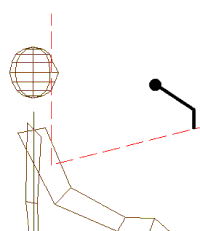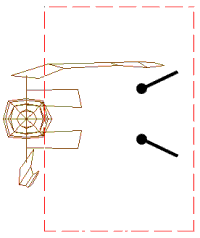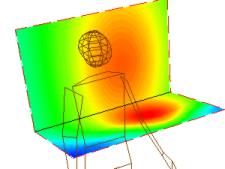
Main Page Related Pages Lavalier vs. lectern mic Array Case Study A/V Systems Intelligibility Calculator Loudspeaker Directivity Sound System Design Speech Intelligibility Video Conference Facilities |
Will that be One Mic or Two?It's a common enough sight on lecterns and pulpits, a pair of microphones positioned to pickup a talker no matter which way they turn their head. It is supposed to be the best way to alleviate a problem with a narrow microphone pickup pattern and having the talker speak "off mic". Unfortunately microphones obey the same laws of physics that loudspeakers do, and that means that a pair of spaced microphones that are summed to a common mix buss will generate the same sort of awful comb filtering that we saw in our examination of poorly configured loudspeaker arrays. This not only causes variations in sound quality, but also creates all sorts of lobes in the pickup pattern (just the inverse of what happens to loudspeakers), which create all sorts of opportunities for early onset of feedback. Luckily, because the same laws of physics apply, the same modeling software used for calculating loudspeaker coverage can be used to predict the pickup pattern of combined microphones. The modeling results shown below are based on a pair of cardioid microphones located 18" (500mm) from the talker's mouth. We've projected the pickup pattern on a plane surface at that distance, identified here as the talker's mouth plane. We've also painted the lectern/pulpit top with the pickup pattern to indicate where this combination will be sensitive to picking up reflected sound. plane, and microphones  Top view of our lectern with the two microphones 
At lower frequencies where the spacing of the two microphones is a fraction of a wavelength, things are pretty well behaved. The image below shows the combined pickup pattern of two cardioid microphones at 500Hz, the microphone spacing is 12" (300mm) . Note the hot spot on the lectern top as well as the general sweetspot on the talker's mouth plane.  500Hz pickup pattern 1000Hz pickup pattern 2000Hz pickup pattern 4000Hz pickup pattern Note that at the talking position exactly between the two microphones all frequencies sum correctly (although the width of that sweet spot narrows with increasingly frequency), but there are some very significant variations in the pickup pattern just off the centreline. In an ideal world, all the pickup patterns should look as smooth and uniform as the red patch in the 500Hz pattern shown above. You can hear this interference as people move and talk in front of the microphones, the very same comb filtering that you can hear moving across the coverage pattern of a misaligned multi-speaker cluster can be heard as you move the source across the pickup pattern of two microphones. As bad as this is for sound quality and uniform high frequency pickup, it is even worse for producing odd little hot spots in the pickup pattern that may coincide with loudspeaker system coverage lobes, reflections from nearby walls or ceilings, or even reflections from the eyeglasses of someone standing beside the talker. How many times have you seen a sound system take off into feedback when something changed beside or around the talker? In reality, this scenario would be even messier since the reflection from the lectern top will add its own interference that we haven't included here (in interest of clarity). So the question of one microphone or two remains. Broadcasters often use the two mic approach to have one there as a spare in case one should fail, or for stereo audio pickup (those are the major reasons you see it on TV). Just make sure anyone operating the system knows that's how it is to be used. For speech reinforcement applications one microphone will provide smoother and more consistent off-axis pickup than two microphones, and will often have much more gain before feedback than a pair of microphones. Two microphones may have slightly wider pickup capability than a single microphone of the same coverage pattern, but when you include the effects of the frequency response and pickup pattern anomalies shown here, you will often find that you can replace two mics with a single microphone with a wider pickup pattern (sometimes even an omnidirectional mic) and still get more gain before feedback. So reduce your microphone budget, simplify the lectern, and improve the sound quality at the same time. It's easy enough to set up a trial on your own to hear these effects, we urge you to try this for yourself. You will also see this same effect with a fixed lectern microphone used with a wireless lapel or headset microphone, although the shape of the pickup pattern anomalies will be very different, the effects are the same. Have a look at our examination of this configuration. Note that you can make two microphones work if you implement a ducking arrangement so that once one microphone receives a louder signal it would duck the other microphone at least 6dB, essentially a microphone diversity receiver. There's still no off-the-shelf system that offers that exact capability (we're waiting!). Check out our loudspeaker array article and our Lavalier battles Lectern Mic article |
